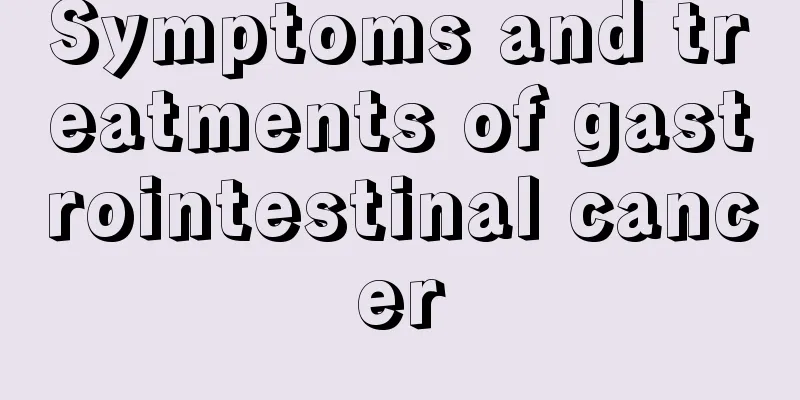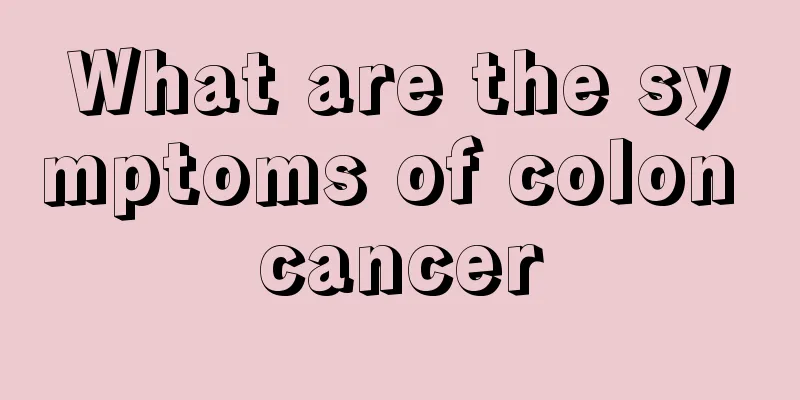Symptoms and treatments of gastrointestinal cancer

|
Gastrointestinal cancer is caused by the malignant transformation of rectal tissue cells. With the improvement of the quality of life, the incidence of gastrointestinal cancer has increased year by year. It is reported that the incidence of colorectal cancer (colon cancer + gastrointestinal cancer) ranks third (the first two are lung cancer and stomach cancer). By 2015, the incidence of colorectal cancer may exceed that of lung cancer and stomach cancer, ranking first. Therefore, it is very important to understand the symptoms and treatment of gastrointestinal cancer. Clinical manifestations 1. Most early gastrointestinal cancers are asymptomatic 2. Patients with advanced cancer (mid- to late-stage) experience symptoms such as abdominal pain, blood in the stool, thinning of the stool, and diarrhea. 1. When gastrointestinal cancer grows to a certain extent, blood in the stool may occur. A small amount of bleeding is not easy to detect with the naked eye, but a large number of red blood cells can be found when examining the stool under a microscope, and the so-called fecal occult blood test is positive. When the amount of bleeding is large, blood in the stool may appear, and the blood may be bright red or dark red. When the surface of the tumor ruptures and forms ulcers, and the tumor tissue becomes necrotic and infected, pus, blood, mucus and blood in the stool may appear. 2. Patients may have varying degrees of feeling of incomplete defecation, a feeling of anal prolapse, and sometimes diarrhea. 3. When rectal tumors cause intestinal stenosis, intestinal obstruction symptoms (abdominal pain, bloating, and difficulty defecating) may occur to varying degrees, with abdominal pain and bowel sounds before defecation, and symptoms alleviated after defecation. The stool may become thinner and grooved. 4. When the tumor invades the bladder and urethra, frequent urination, urgent urination, painful urination, and difficulty urinating may occur; when the tumor invades the vagina, rectovaginal fistula and fecal discharge from the vagina may occur; when the tumor invades the sacrum and nerves, severe pain in the sacrum and perineum may occur; when the tumor invades and compresses the ureter, distension and pain in the waist may occur; the tumor may also compress the external iliac blood vessels and cause lower limb edema. The above symptoms all indicate that the tumor is in a relatively late stage. 5. When the tumor metastasizes to distant sites (liver, lungs, etc.), symptoms may occur in the corresponding organs. For example, dry cough and chest pain may occur when the tumor metastasizes to the lungs. 6. Patients may experience varying degrees of fatigue, weight loss and other symptoms. Patients with the above symptoms (abdominal pain, blood in the stool, thin stool, diarrhea, etc.) are advised to go to a regular hospital anorectal clinic for treatment. Do not attribute the above symptoms to hemorrhoids. Rectal digital examination can detect about 70% of gastrointestinal cancers. Many patients delay treatment because they mistake gastrointestinal cancer for hemorrhoids. Surgery 1. For stage 0 gastrointestinal cancer; submucosal cancer with a tumor size less than 2 cm and mild infiltration: endoscopic mucosal resection (EMR) or transanal endoscopic microsurgery (TEM) can be used. Pay attention to regular review and follow-up after surgery. 2. Bowel resection + lymph node dissection (D2 or D3) is used for stage 0 gastrointestinal cancer with a tumor larger than 2 cm, deep submucosal cancer, and stage II and III cancers. 3. For stage IV gastrointestinal cancer (gastrointestinal cancer with distant metastasis, etc.) (1) If both gastrointestinal cancer and metastatic cancer can be removed, surgical resection is performed. (2) For gastrointestinal cancer that cannot be removed from both the metastatic cancer and the primary lesion, non-surgery treatment measures (chemotherapy, radiotherapy, etc.) are used (3) For gastrointestinal cancers where metastatic lesions can be removed but primary lesions cannot, non-surgical treatments (chemotherapy, radiotherapy, etc.) are used. (4) For gastrointestinal cancer patients whose metastatic lesions cannot be removed but whose primary lesions can be removed, surgical resection of the primary lesion can be considered, and non-surgical treatment measures can be adopted for the metastatic lesions. For gastrointestinal cancer patients without major bleeding, severe anemia, stenosis, or perforation (whose metastatic lesions cannot be removed but whose primary lesions can be removed), non-surgical treatment measures can also be adopted. Radiation therapy Radiotherapy has its advantages and disadvantages. Please refer to other literature (Colorectal Tumors, edited by Luo Chenghua) for details. 1. Completely resectable gastrointestinal cancer (1) Surgery is performed first. If the tumor is T3 and/or N1-2, adjuvant comprehensive treatment including radiotherapy is performed. (2) Preoperative neoadjuvant therapy (radiotherapy or chemoradiotherapy) followed by surgery. For patients with ultrasound-diagnosed T3 or clinical T4 disease, postoperative adjuvant comprehensive therapy is added. (3) Simple intracavitary radiotherapy, mainly for individual early localized tumors. (4) Local surgical resection combined with radiotherapy is mainly to increase the chance of preserving the anus and can be used for relatively early tumors. 2. Gastrointestinal cancer that cannot be completely removed or resected 3. The patient refuses surgery or his physical condition does not allow surgery Note: With the application of total mesorectal excision (TME) technology, there is still controversy about whether postoperative radiotherapy should be performed for completely resectable gastrointestinal cancer. |
<<: Briefly describe the treatment principles of gastric cancer
>>: Can I exercise during gastric cancer?
Recommend
How long can you live with diarrhea in the late stage of bladder cancer
How long can you live with diarrhea in the late s...
What are the folk remedies for treating advanced lung cancer? What is the best diet for lung cancer patients?
Lung cancer is a very serious disease. It threate...
What is the best way to treat hemorrhoids
Hemorrhoids are a common anorectal disease. They ...
How to solve the problem of choking when drinking water
Many of us may have experienced choking when drin...
Wash your face with wild chrysanthemum water
Wild chrysanthemum has many functions. People oft...
How to install a zipper pull? Introducing detailed steps!
In daily life, we often encounter situations wher...
Can sinusitis be cured by laser?
Some patients with severe sinusitis can only unde...
How to diagnose nasopharyngeal cancer in pregnant women
There are many methods to treat nasopharyngeal ca...
Why does my wrist hurt when I box?
Some friends who like boxing may find that their ...
Why red wine helps prevent prostate cancer
Nowadays, the incidence of cancer is very high. T...
What is the treatment for pancreatic cancer
Pancreatic cancer occurs frequently in our daily ...
What are some ways to protect the knee joint?
The knee joint is relatively fragile. If it is no...
Are bacteria harmful to the human body?
When I was a child, my parents often told me to w...
What are the diagnostic measures for colon cancer
The impact of colon cancer on people's bodies...
What are the benefits of eating lamb kidneys
Lamb is a meat that most people like. Many people...









